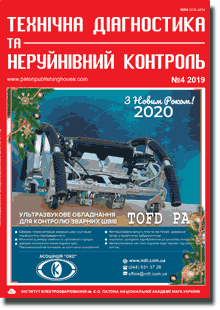| 2019 №04 (05) |
DOI of Article 10.15407/tdnk2019.04.06 |
2019 №04 (07) |

"Tekhnichna Diahnostyka ta Neruinivnyi Kontrol" (Technical Diagnostics and Non-Destructive Testing) #4, 2019, pp. 50-57
Analysis of behaviour of dissimilar steel welded joint in the structure of reforming process pipeline of a reactor block
S.Z. Stasyuk
G.P. Pisarenko Institute for Problems of Strength of the NAS of Ukraine. 2 Timiryazevskaya Str., 01014, Kyiv. E-mail: ips@ipp.kiev.ua
The paper deals with the features of fracture of reforming process pipeline of a reactor block transporting working product with up to 85% hydrogen content, with operating time of 200 000 h at 520 C and medium pressure of 5.3 MPa. In the pipeline structure pipes from steel 15Kh5M of martensitic class were joined by austenitic welds to each other and to a flange from steel 20 of pearlitic class. It is shown that microstructure of the pipe base metal, weld and HAZ metal did not undergo any essential changes from the impact of hydrogen-containing medium during long-term service. However, hydrogen corrosion occurred in the flange material, which was manifested in decarbonization and degradation of metal properties that led to welded joint fracture. Decarbonized zones which formed around the pure graphite chains (cementite decomposition products) and coagulated cementite particles weakened the matrix and caused brittle fracture. It is found that the crack propagated through the flange metal in the areas of normalizing and incomplete recrystallization of the HAS. 23 Ref., 5 Tabl., 6 Fig.
Keywords: hydrogen-containing medium, process pipelines, long-term service; metallographic studies, metal microstructure, mechanical testing, characteristics of strength, ductility and impact toughness, brittleness temperature, property degradation, fracture
Received: 20.09.2019
Published: 11.12.2019
References
1. Belchuk, G.A., Zemzin, V.N. (1978) Welding of dissimilar steels, metals and alloys. Welding in machine-building. Ed. by A.I. Akulov. Moscow, Mashinostroenie, Vol. 2, pp. 322-364 [in Russian].2. Gotalsky, Yu.N. (1981) Welding of dissimilar steels. Kiev, Tekhnika [in Russian].
3. (2007) STO-00220368-011-2007: Welding dissimilar joints of vessels, apparatuses and pipelines from carbon-, low-alloy, high-temperature, high-alloy steels and alloys on iron-nickel and nickel bases. Volgograd [in Russian].
4. (2017) Technical diagnostics of materials and structures: Refer. book. In: 8 Vol. Ed. by Z.T.Nazarchuk. Lviv, Prostir-M [in Ukrainian].
5. Nelson, G.G. (1988) Hydrogen embrittlement. Embrittlement of structural steels and alloys. Ed. by K.L.Brajent, S.K. Benerdzhi. Moscow, Metallurgiya, 256-333 [in Russian].
6. Kryzhanivskyi, E.I., Ostash, O.P., Nykyforchyn, G.M. et al. (2016) Service degradation of structural materials. Vol. 1. Lviv, Prostir-M [in Ukrainian].
7. Nechaev, Yu.S. (2008) Metallic materials for the hydrogen energy industry and main gas pipelines: Complex physical problems of aging, embrittlement, and failure. Phys. Usp., 51, 681-697 [in Russian]. https://doi.org/10.1070/PU2008v051n07ABEH006570
8. Pakhmurskyi, V.I., Fedorov, V.V. (1981) Some peculiarities of hydrogen effect on magnetic and structural transformations in transition metals and alloys on their base. Fiz.-Khimich. Mekhanika Materialov, 1, 3-11 [in Russian]. https://doi.org/10.1007/BF01156717
9. Kolachev, B.A. (1985) Hydrogen brittleness of metals. Moscow, Metallurgiya [in Russian].
10. Archakov, Yu.I. (1985) Hyrdogen corrosion of steels. Moscow, Metallurgiya [in Russian].
11. Stasyuk, S.Z. (2018) Monitoring the technical condition of process pipelines in long-term service in hydrogen-containing working medium. Tekh. Diagnost. i Nerazrush. Kontrol, 1, 8-20 [in Russian]. https://doi.org/10.15407/tdnk2018.01.02
12. Panchenko, E.V., Skakov, Yu.A., Krimer, B.I. et al. (1965) Laboratory of metallography. Moscow, Metallurgizdat [in Russian].
13. Kovalenko, V.S. (1970) Metallographic reagents: Refer. book. Moscow, Metallurgiya [in Russian].
14. GOST 5639-82: Steels and alloys. Methods for identifying and determining grain size [in Russian].
15. GOST 1778-70: Steel. Metallographic methods for detection of nonmetallic inclusions [in Russian].
16. GOST 8233-56: Steel. Microstructure standards.
17. DSTU EN 1002-1: 2006: Materials are metal. Tensile test. Pt 1: Test method at room temperature [in Ukrainian].
18. DSTU EN 1002-5: 2018: Materials are metal. Tensile test. Pt 5: Test method at elevated temperatures [in Ukrainian].
19. DSTU EN 10045-1:2018: Charpy impact test on metallic materials. Pt. 1. Test method [in Ukrainian].
20. GOST 6996-66 (ISO 4136-89, ISO 5173-81, ISO 5177-81): Welded joints. Methods of mechanical properties determination [in Russian].
21. Zaks, I.A. (1973) Welding of dissimilar steels. Moscow, Mashinostroenie [in Ukrainian].
22. (2010) NPAOP 0.00-6.09-10: Procedure for conducting inspection, testing and expert examination of equipment of plants of hydrogenation processes in oil refining, petrochemical and chemical production [in Ukrainian].
23. (2018) NPAOP 0.00-1.81-18: Occupational safety rules during operation of pressure equipment [in Ukrainian].
The cost of subscription/purchase order journals or individual articles
| Journal/Currency | Annual Set | 1 issue printed |
1 issue |
one article |
| TPWJ/USD | 384 $ | 32 $ | 26 $ | 13 $ |
| TPWJ/EUR | 348 € | 29 € | 24 € | 12 € |
| TPWJ/UAH | 7200 UAH | 600 UAH | 600 UAH | 280 UAH |
| AS/UAH | 1800 UAH | 300 UAH | 300 UAH | 150 UAH |
| AS/USD | 192 $ | 32 $ | 26 $ | 13 $ |
| AS/EUR | 180 € | 30 € | 25 € | 12 € |
| SEM/UAH | 1200 UAH | 300 UAH | 300 UAH | 150 UAH |
| SEM/USD | 128 $ | 32 $ | 26 $ | 13 $ |
| SEM/EUR | 120 € | 30 € | 25 € | 12 € |
| TDNK/UAH | 1200 UAH | 300 UAH | 300 UAH | 150 UAH |
| TDNK/USD | 128 $ | 32 $ | 26 $ | 13 $ |
| TDNK/EUR | 120 € | 30 € | 25 € | 15 € |
AS = «Automatic Welding» - 6 issues per year;
TPWJ = «PATON WELDING JOURNAL» - 12 issues per year;
SEM = «Electrometallurgy Today» - 4 issues per year;
TDNK = «Technical Diagnostics and Non-Destructive Testing» - 4 issues per year.





